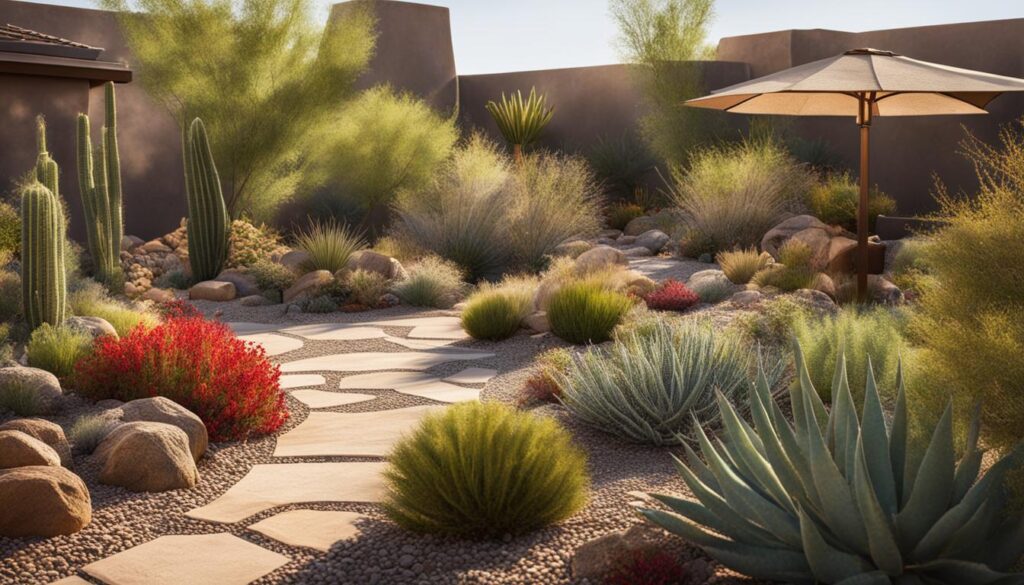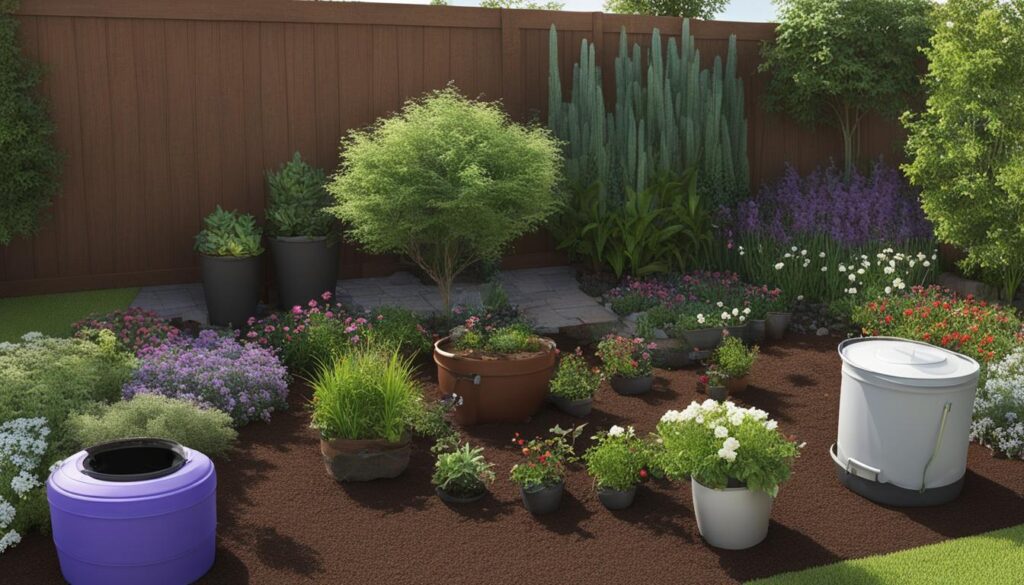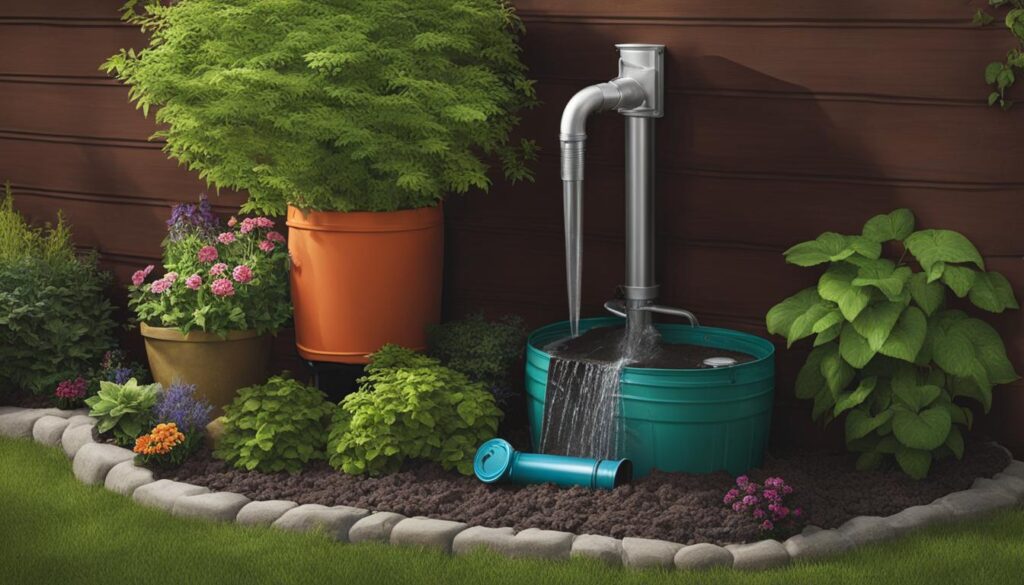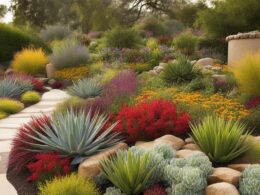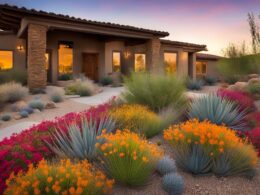Creating a beautiful, low-maintenance garden that can withstand drought conditions is now within reach. By incorporating water retention techniques into your xeriscaping soil, you can revolutionize your garden and transform it into a stunning oasis that requires less water and maintenance.
Key Takeaways:
- Implementing water retention techniques in xeriscaping soil can create a low-maintenance, drought-resistant garden.
- Xeriscaping is a water-wise and budget-friendly approach to landscaping that promotes water conservation.
- Amending the soil, mulching plants, and selecting drought-tolerant species are key principles of xeriscaping.
- Grouping plants based on their water needs and reducing areas of turfgrass further optimize water conservation.
- Efficient watering techniques and using a rain barrel system can also contribute to water conservation in xeriscaping.
What Does Xeriscaping Mean?
Xeriscaping is a water-efficient landscaping technique that is gaining popularity among homeowners and garden enthusiasts. This water-saving approach focuses on designing and maintaining a landscape that requires minimal water while still creating a beautiful and sustainable outdoor space.
The term “xeriscaping” originated from the Greek root word “xeros,” which means dry. This reflects the main goal of xeriscaping, which is to create a landscape that thrives in dry conditions with limited water resources. By implementing xeriscaping techniques, you can transform your garden into a water-wise oasis without sacrificing its aesthetic appeal.
“Xeriscaping is all about using water efficiently and conserving water in the landscape.”
With xeriscaping, you can reduce water consumption by implementing practices such as soil amendment, mulching, and selecting drought-tolerant plants. These strategies help the soil retain moisture, minimize evaporation, and reduce the overall water requirements of your garden.
| Benefits of Xeriscaping | Water-Efficient Landscaping | Water-Saving Approach |
|---|---|---|
| 1. Conservation of water resources | 1. Decreases water usage | 1. Minimizes water wastage |
| 2. Lower water bills | 2. Optimizes water consumption | 2. Reduces water-related expenses |
| 3. Reduced maintenance requirements | 3. Simplifies garden care | 3. Saves time and effort |
Benefits of Xeriscaping
- Conservation of water resources
- Lower water bills
- Reduced maintenance requirements
By adopting xeriscaping as a water-saving approach, you can contribute to a more sustainable future while still enjoying a vibrant and thriving garden.
Principles of Xeriscaping
Implementing the principles of xeriscaping is essential to ensure water conservation and create a sustainable garden. By following these principles, you can optimize water usage and create a beautiful landscape that thrives in drought conditions.
Soil Amendment
One of the key principles of xeriscaping is amending the soil to improve water retention. By adding compost and organic matter to the soil, you can create a well-draining soil that retains moisture more effectively. This helps plants access water while reducing the need for excessive watering. Additionally, amending the soil improves its overall health and fertility, benefiting the entire garden ecosystem.
Mulching
Mulching is another important technique in xeriscaping that helps conserve water. By applying a layer of organic mulch, such as wood chips or shredded bark, around the base of plants, you can reduce evaporation and regulate soil temperature. Mulch also suppresses weed growth, reducing competition for water. This technique not only helps conserve water but also reduces the need for frequent irrigation and maintenance.
Selection of Suitable Plants
Choosing drought-tolerant and native plants is crucial in xeriscaping. These plants are adapted to the local climate, soil conditions, and rainfall patterns, making them naturally more resilient and requiring less water. By selecting suitable plants for your garden, you can ensure their survival even during periods of drought. Moreover, native plants promote biodiversity and attract local wildlife, enhancing the overall ecological balance of your garden.
Grouping Plants According to Water Needs
Grouping plants with similar water requirements is an effective way to optimize water usage in xeriscaping. By creating zones with plants that have similar water needs, you can tailor your irrigation system or hand-watering approach to meet those needs more efficiently. This prevents overwatering or underwatering, ensuring that each plant receives the appropriate amount of water. Grouping plants also allows you to customize your garden design based on aesthetic preferences and functional considerations.
By incorporating these principles into your xeriscaping efforts, you can create a water-efficient and visually appealing landscape that conserves water, reduces maintenance, and thrives in drought conditions.
Amend the Soil
One of the fundamental principles of xeriscaping is amending the soil to improve water retention. By adding compost and organic matter to your soil, you can enhance its ability to retain moisture while still ensuring it remains well-drained. This creates an optimal growing environment for your plants and reduces the need for excessive watering.
Amending the soil with compost helps increase its water-holding capacity. Compost is rich in organic matter, which acts as a sponge, absorbing and retaining water. This moisture is then slowly released to the plants’ roots, keeping them hydrated for longer periods. Additionally, the organic matter in compost also improves soil structure, making it looser and more porous, allowing for better water infiltration.
When amending your soil, it’s important to use well-rotted compost to avoid any potential nutrient imbalances or harm to your plants. Spread a layer of compost over the soil and mix it in thoroughly to ensure its integration. Aim to amend the soil to a depth of at least 6-8 inches, as this will provide the best results in terms of water retention.
Benefits of Amending Soil for Water Retention
Amending the soil in your xeriscaping garden offers several benefits related to water retention:
- Improved water-holding capacity: Amended soil can hold water more effectively, ensuring that your plants have access to the moisture they need.
- Reduced water runoff: Amended soil helps slow down water runoff, allowing more time for the water to be absorbed by the plants’ roots.
- Decreased watering frequency: With increased water retention, you can reduce the frequency of watering, saving both time and resources.
- Enhanced plant health: Well-draining soil prevents waterlogged conditions, reducing the risk of root rot and other plant diseases.
Amending the soil is a crucial step in creating a successful xeriscaping garden. By following this practice, you can improve water retention, promote healthy plant growth, and contribute to water conservation efforts.
| Benefits of Amending Soil | |
|---|---|
| Improved water-holding capacity | |
| Reduced water runoff | |
| Decreased watering frequency | |
| Enhanced plant health |
Mulch Your Plants
Mulching is a crucial technique in xeriscaping that offers numerous benefits for your garden. It helps retain moisture in the soil, suppresses weed growth, and regulates soil temperature, creating a favorable environment for your plants to thrive. By applying a layer of organic mulch around the base of your plants, you can significantly reduce evaporation and conserve water, making it an essential practice in water-wise landscaping.
Organic mulch, such as wood chips or shredded bark, is ideal for xeriscaping as it decomposes slowly, providing long-term moisture retention. As the mulch breaks down, it enriches the soil with nutrients, promoting healthier plant growth. Additionally, the layer of mulch acts as a natural weed barrier, reducing the need for excessive weeding and minimizing competition for water resources.
When applying mulch, make sure to leave a small gap around the base of your plant to prevent moisture buildup and potential rot. Maintain a layer of mulch that is about 2-4 inches thick, evenly spread throughout the designated area. Regularly check the mulch layer to ensure its thickness and replenish as needed to maintain optimal moisture retention.
Select Suitable Plants
Choosing the right plants for your xeriscaping project is crucial when it comes to water conservation. Opting for drought-tolerant plants, especially native species, can significantly reduce your water consumption while ensuring a high survivability rate in your garden. These plants are well-adapted to the local climate, soil conditions, and rainfall patterns, making them resilient and less dependent on supplemental watering.
Native plants are particularly suitable for xeriscaping because they have evolved to thrive in the specific environmental conditions of your region. They have developed mechanisms to survive with minimal water, such as deep root systems that can access moisture deep within the soil and waxy or hairy leaves that help reduce water loss through evaporation. By incorporating these plants into your landscape, you can create a water-efficient and sustainable garden.
Benefits of Drought-Tolerant and Native Plants in Xeriscaping
By selecting suitable plants for xeriscaping, you can reap several benefits:
- Water efficiency: Drought-tolerant plants require less water, saving you both time and money on irrigation.
- Reduced maintenance: These plants typically have lower maintenance requirements, as they are adapted to local conditions and can tolerate periods of limited watering.
- Biodiversity: Native plants support local ecosystems by providing habitat and food sources for native insects, birds, and other wildlife.
- Visual appeal: Native and drought-tolerant plants come in a variety of shapes, colors, and textures, allowing you to create a beautiful and diverse landscape.
When selecting suitable plants, consider factors such as sun exposure, soil type, and the specific water needs of each plant. Consulting with local nurseries or landscape professionals can provide valuable guidance on choosing the right plants for your xeriscaping project.
Group Plants According to Water Needs
One of the key principles in xeriscaping is grouping plants according to their water needs. This allows for more efficient irrigation, ensuring that water is not wasted on plants that don’t require as much moisture. By dividing your garden into zones with plants that have similar water requirements, you can create a well-organized and water-conscious landscape.
Efficient Irrigation Techniques
Efficient irrigation is crucial in maintaining the water balance in your xeriscaped garden. By implementing zone watering, you can program your irrigation system or hand-water specific sections based on their water requirements. This targeted approach not only conserves water but also promotes healthier plant growth as each plant receives the ideal amount of moisture.
Another way to ensure efficient irrigation is by using drip irrigation systems or soaker hoses instead of traditional sprinklers. These methods deliver water directly to the plant’s root zone, minimizing evaporation and runoff. Additionally, regularly monitoring and adjusting your watering schedule based on weather conditions and plant needs can further optimize water usage.
Creating a Zoning Plan
Creating a zoning plan for your xeriscaped garden is essential to effectively group plants based on their water needs. Start by assessing the water requirements of each plant species in your landscape. Consider factors such as their native habitat, drought tolerance, and growth habits. This will help you determine the optimal zones and watering schedules for each group.
| Zone 1: High-Water Plants | Zone 2: Moderate-Water Plants | Zone 3: Low-Water Plants |
|---|---|---|
| Water-loving plants such as ferns or water lilies | Plants that require regular watering but can tolerate some drought, like roses or hydrangeas | Drought-tolerant plants that can thrive with minimal water, such as succulents or lavender |
| Water every 1-2 days | Water every 3-4 days | Water every 5-7 days |
By creating a zoning plan and adhering to efficient irrigation practices, you can ensure that your plants receive the right amount of water while minimizing water waste. This approach not only saves water but also promotes a sustainable and thriving xeriscaped garden.
Reduce Areas of Turfgrass in Your Yard
Turfgrass, while beautiful, can be a water-guzzler in your garden. By reducing the areas of turfgrass in your yard, you can significantly decrease water usage and create a more sustainable landscape. Instead of vast expanses of lawn, consider incorporating flowerbeds and mulched islands into your design.
Flowerbeds not only add vibrant colors and textures to your garden but also require less water compared to turfgrass. Choose a variety of drought-tolerant plants that thrive in your region, such as native wildflowers or succulents, to create a visually stunning flowerbed that conserves water.
“Reducing the areas of turfgrass in your yard by converting them into flowerbeds or mulched islands can significantly decrease water usage.”
Mulched islands are another excellent alternative to traditional lawns. By replacing sections of turfgrass with mulched areas, you can reduce the need for regular watering and minimize soil erosion. Choose a high-quality organic mulch, such as wood chips or bark, to retain moisture in the soil, suppress weed growth, and create an aesthetically pleasing contrast within your garden.
By embracing these alternatives to turfgrass, you not only conserve water but also create a more dynamic and environmentally friendly landscape that enhances the beauty of your yard.
| Benefits of Reducing Turfgrass | Flowerbeds | Mulched Islands |
|---|---|---|
| Conserves water | Requires less water compared to turfgrass | Reduces the need for regular watering |
| Enhances visual appeal | Adds vibrant colors and textures | Creates an aesthetically pleasing contrast |
| Reduces maintenance | Requires less mowing and maintenance | Minimizes soil erosion |
Efficient Watering Techniques
To achieve efficient watering in xeriscaping, it is important to implement proper irrigation practices and maintain a consistent watering schedule. By optimizing water usage, you can effectively conserve water while nurturing a thriving garden.
Water Conservation
Water conservation is a key objective in xeriscaping. By using efficient irrigation methods, you can significantly reduce water waste. It is crucial to water plants only when necessary and avoid overwatering, which can lead to root rot and other plant diseases. Implementing drip irrigation systems or soaker hoses, which deliver water directly to the plant roots, is an effective way to minimize evaporation and deliver water precisely where it is needed.
Watering Schedule
Establishing a consistent watering schedule is essential in xeriscaping. By watering plants at specific times of the day, you can maximize water absorption and minimize evaporation. It is recommended to water early in the morning or late in the evening when temperatures are cooler and evaporation rates are lower. Avoid watering during the midday heat when water is more likely to evaporate before reaching the plant roots.
Monitoring soil moisture levels is crucial in determining when to water. Stick your finger into the soil to a depth of 1-2 inches. If the soil feels dry at this depth, it’s time to water. Consider using moisture-sensing devices or installing smart irrigation systems that adjust watering schedules based on soil moisture levels, weather conditions, and plant water needs.
Quotes:
“Proper irrigation practices are essential for water conservation in xeriscaping. By optimizing your watering schedule and using efficient irrigation methods, you can minimize water waste and promote a sustainable garden.”
Efficient Irrigation:
- Drip irrigation systems deliver water directly to plant roots, minimizing evaporation.
- Soaker hoses provide slow and steady watering, reducing runoff and water waste.
- Smart irrigation systems adjust watering schedules based on soil moisture levels and weather conditions.
Watering Tips:
- Water plants early in the morning or late in the evening to reduce evaporation.
- Stick your finger into the soil to determine when to water; if it feels dry 1-2 inches deep, it’s time to water.
- Use moisture-sensing devices or smart irrigation systems to optimize water usage.
| Watering Method | Advantages | Disadvantages |
|---|---|---|
| Drip Irrigation | – Delivers water directly to plant roots – Minimizes evaporation and water waste – Reduces weed growth |
– Initial installation cost – Requires periodic maintenance – Can be clogged by mineral deposits |
| Soaker Hoses | – Provides slow, uniform watering – Reduces runoff and water waste – Easy to install and use |
– Limited coverage area – Can be damaged by freezing temperatures – Requires periodic inspection for leaks |
| Smart Irrigation Systems | – Adjusts watering schedules based on soil moisture levels and weather conditions – Optimizes water usage – Can be programmed for specific plant water needs |
– Higher initial cost – Requires periodic maintenance and reprogramming – May require professional installation |
By implementing efficient watering techniques, you can ensure that your xeriscaping garden receives the right amount of water while minimizing waste. Conserving water not only benefits the environment but also reduces your water bills. With proper irrigation practices, you can create a sustainable and beautiful garden that thrives in a water-wise landscape.
Use a Rain Barrel System
One effective way to conserve water in your xeriscaped garden is by utilizing a rain barrel system. This eco-friendly technique allows you to capture and store rainwater runoff from your roof, which can then be used to water your plants during dry periods.
By implementing a rain barrel system, you can significantly reduce your reliance on municipal water sources, conserve water, and minimize your environmental impact. It’s a simple yet effective solution that can make a big difference in water conservation.
Using rainwater collected in a barrel is not only beneficial for your garden but also for your wallet. By reducing your dependence on municipal water, you can lower your water bills and save money in the long run.
Installing a rain barrel system is relatively easy and can be customized to fit your specific needs. You can choose from a variety of barrel sizes and styles to suit your garden’s requirements. With proper maintenance and regular use, a rain barrel system can contribute to the sustainable and water-conscious practices of xeriscaping.
How Does Soil Organic Matter Help with Water Retention in Xeriscaping?
Waterwise soil organic matter plays a crucial role in xeriscaping by enhancing water retention. It improves soil structure, allowing it to hold onto moisture for longer periods. This helps to reduce the need for frequent irrigation and supports the growth of drought-resistant plants in xeriscapes.
Conclusion
Xeriscaping offers a multitude of benefits that make it an excellent choice for creating a sustainable and water-conscious garden. By implementing water retention techniques in xeriscaping soil and following the principles of xeriscaping, you can transform your garden into a beautiful, low-maintenance, and drought-resistant oasis.
One of the key advantages of xeriscaping is water conservation. With the use of soil amendments, such as compost and organic matter, your garden’s soil can retain more water while remaining well-drained. Additionally, mulching plants with organic materials helps retain moisture, suppresses weed growth, and regulates soil temperature, reducing the need for excessive watering.
Xeriscaping also promotes sustainable gardening by encouraging the selection of suitable plants. Drought-tolerant plants, especially native species, are well-adapted to the local climate and require less water, resulting in reduced water consumption and increased survivability. Grouping plants based on their water needs and reducing areas of turfgrass further optimize water usage and add visual interest to your garden.
Embracing xeriscaping not only contributes to a more water-conscious future, but it also offers practical benefits, such as decreased water bills and reduced maintenance requirements. Whether you live in an area prone to drought or simply want to create a beautiful and environmentally friendly garden, implementing xeriscaping techniques can revolutionize your outdoor space and help conserve water for years to come.






